If there is one complaint most Boston Celtics fans and basketball media personalities have both raised their eyebrows about with this Cs team, it has been their clutch offense. Particularly their very end-of-game offense.
Imagine for a second, it's the fourth quarter of a tie game. The clock is just under one minute remaining and Boston has the ball. What kind of play do you think you're going to see? More often than not, the answer is a Jayson Tatum or Jaylen Brown isolation, as was seen at the end of regulation in the last Atlanta game with a tied score.
Not much of an action was run; just get Tatum the ball and see what happens was the gameplan instead.
This criticism has plagued the Celtics over the last several years. Many have asked why their offense seems to slow down in close games and they start playing the clock instead of the opponent. They don't run much off-ball action and revert to a version of hero ball starring its two All-NBA wings. But what do the stats say?
Is that all they are doing in crunch time and is that the worst thing they could be doing?
As a team, the Celtics have been a competent clutch team. Although they only rank No. 21 in clutch frequency purely because of their regular season dominance. The trouble comes when looking at their post-All-Star numbers, something that becomes concerning with the playoffs only a few weeks away. Overall, Boston has a 122 offensive clutch rating (6th best), and a 105.2 defensive rating (8th best), with a 16.9 net rating.
Post-All-Star break, however, those numbers drop to 112 (15th) and 121 .3 (22nd) with a -9.3 net rating. Combine this with the prior years' critiques of their late-game offense and it's a fair point.
In that same game against Atlanta, at the end of overtime, the Celtics did call something different though. They ran things through Kristaps Porzingis and had Tatum cut to the basket. This allowed Brown to get just enough space to catch the pass and make a tough shot at the elbow.
While it was still not an open shot, it did have the off-ball movement you would want to see. It didn't lead to a wide-open look but to Brown's credit, he's been making those kinds of shots all year. A majority of his shot diet (37.1 percent) comes in the form of 2-point field goals with a defender within 2-4 feet, and he's making them at 60.4 percent. So while wasn't an open shot, it was still a good shot.
By comparison, the same can't be said about Tatum's shot at the end of regulation, a contested pull-up three. Tatum is shooting 35.2 percent on pull-up threes this year, and only 34 percent on threes with a defender within 2-4 feet. Granted, the play call wasn't necessarily for Tatum to take an off-balance pull-up three here but that is the root of the criticism. The play was to get the ball to Tatum and leave the game in his hands. Not an uncommon thing in the history of the NBA to just get the ball to your star, but why not call something to get him the ball with a better opportunity to score?
Perhaps that's exactly why head coach Joe Mazzulla chose the play he did that led to Brown's bucket. It had both him and Tatum in the action and in the mid to close range. Tatum, like Brown, is shooting very well on 2-pointers with defenders close to him (53.2 percent with a defender 0-2 feet, and 55.5 percent with a defender 2-4 feet).
Still, Mazzulla stuck by his end-of-game play call. “Give JT the ball and have him make a play for us,” Mazzulla said after the game. “He got a shot off. Got a good look, but it didn’t go.”
Clearly, Mazzulla put trust in his guy, which is also important, but Tatum has been in a bit of rut in end-of-game situations. Within the last two minutes of games with the Celtics either behind or up by five, Tatum is shooting only 6 for 21 on two-point field goals and has only one unassisted three (per pbpstats.com).
Regardless, Tatum moves forward, looking to the positive.
“I know I missed a couple [game-winners] this year,” Tatum said. “So I was like, ‘Damn, I gotta be due for one.’ I hit a bunch of them in my career so far. That’s part of it. Make-or-miss league. I enjoy being in those situations.”
It's also important to note the difference in the situations.
“Those are two different plays,” Mazzulla said. “That one is for end-of-games when you get the last shot. The other one (the Brown play) is you are down one so you draw up a two-for-one play because you want to extend the game. Two different situations.”
It should be encouraging that Mazzulla is trying to always think ahead.
Boston Celtics picking their spots better could make all the difference in playoffs
The Celtics currently sit comfortably in the one seed, a full 11 games above Milwaukee as of this writing, with only eight regular season games left on the schedule. Their regular season performances have been mostly spectacular but it is from the playoffs this team will ultimately be judged. Both the coach and players appear to have put the Atlanta losses behind them and plan on moving on. They will enter the postseason with the most talent they've had since 2008.
With that talent though, comes the advantage of being able to make tough shots. They just need to pick their spots carefully and find a better rhythm in close games, one that mimics their pre-All-Star numbers, not the opposite.
